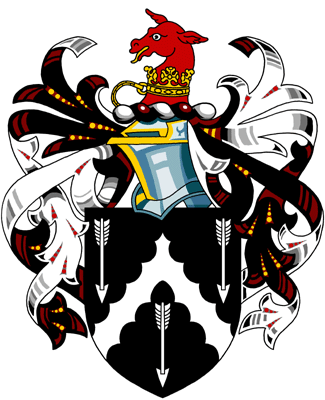 |
 |
|||
|
|
The Forster family originally came from Northumberland. The name means 'Forester'. This branch of the family moved south and settled at Harpsden, near Henley-on-Thames, in Oxfordshire. In 1492, George Forster of Harpsden inherited the Aldermaston estate in West Berkshire from his childless brother-in-law, Thomas de la Mare, and made the house the main family residence. Like many of the family after him, George served as Sheriff of Berkshire, but he was better connected at Court than most and, in 1525, was made a Knight of the Bath. His superb monument in Aldermaston Church shows that his influence was enough to secure the very best of craftsmen in his employ. Sir George's son, Sir Humphrey Forster was more of a local celebrity, though he was also an Esquire of the body to King Henry VIII. Being married to the daughter of the Lord Chamberlain, Lord Sandys of the Vyne (at Sherborne St. john near Basingstoke), he seems to have been very full of his own importance and took to bullying his neighbours to such an extent that it resulted in an armed clash at both Padworth and Ufton. Perhaps this was not always typical of him however, for Fuller praises him amongst the county's 'worthies'. He was a good protestant and complained to the King when he found himself obliged to convict the Windsor Martyrs to death, despite his misgivings. William, Humphrey's eldest son, failed to obtain a knighthood, but he was an MP (Berks) and did entertain Queen Elizabeth I at his home in 1568. She returned to see his son, another Sir Humphrey MP (Berks & Reading), nearly thirty years later. He was Sheriff of Berkshire and the man who escorted St. Edmund Campion to his final imprisonment at the Tower of London. Another Sir William, a Knight of the Bath, followed, but it was his son, yet another Sir Humphrey, who was most prominent, being given a early baronetcy by James I in 1620. This man was well known for his hospitality and is mentioned favourably a number of times in the diary of his distant cousin, Sir Bulstrode Whitelocke. He rebuilt Aldermaston House just before the Civil War when he became an important Royalist, despite being a 3rd cousin of Oliver Cromwell. His reputation was such that his estate was ransacked by Sir Henry Marten's levellers. However, he managed to walk the tightrope between the two sides and entertained both Royalist and Parliamentary commanders when obliged to do so. He spent his last years fighting with his hated brother-in-law and neighbour, Sir Elias Ashmole. Sir Humphrey had sixteen children, but few survived him. The baronetcy was inherited by his grandson, the son of his second son, William. he was a third Sir Humphrey MP (Berks). He had had a brother, John, who was killed in a duel. The three children of the last baronet all died under the age of ten and the dynasty came to an end. In 1711, the family estates passed to his sister, Elizabeth Pert. Her only daughter married one of the Forsters from Bamburgh in Northumberland, but the name did not continue as they had no children. Over the years the family had married into the Kingsmills of Sydmonton (Hampshire), the Stewards of Stantney (Cambridgeshire) & Shinfield, the Barretts of Aveley (Essex) & Stanford Dingley, the Hungerfords of Down Ampney (Gloucestershire) & East Shefford, the Sandys of Sherborne St. John (Hampshire), Pratt of Coleshill and, of course, the De la Mares of Aldermaston. Barrett and Steward were used as Christian names in the family. There don't appear to have been any obvious younger branches of the Aldermaston Forsters. The Aldermaston family is certainly not related to Anthony Forster of Cumnor. He came from Shropshire and used the arms of Forster of Bamburgh. The Forsters quartered their arms with those of Harpsden, Popham, St. Martin, De la Mare, Achard, Barrett, Belhouse, Foxcot, Stokes and Brimpton. The family appears in the Heralds' Visitations of Berkshire for 1532, 1566 and 1665/6. There are eight Forster wills listed in the records of the Archdeaconry of Berkshire between 1508 and 1710, but the name is relatively common and often confused with Foster. There are seventeen Berkshire wills listed in the records of the Prerogative Court of Canterbury.
|
|||
| © Nash Ford Publishing 2010. All Rights Reserved. | ||||



 The
Forster Family
The
Forster Family